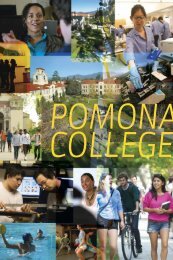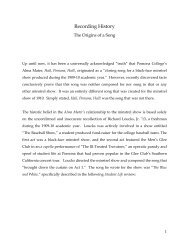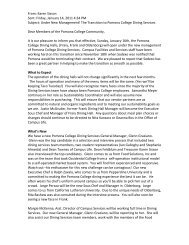Create successful ePaper yourself
Turn your PDF publications into a flip-book with our unique Google optimized e-Paper software.
INTERDISCIPLINARY APPROACH:<br />
Why <strong>Pomona</strong>: I chose <strong>Pomona</strong> mostly because of the small school<br />
environment. A lot of the liberal arts colleges are on the east coast, and I<br />
wanted to be closer to home and not in the freezing cold. The sciences at<br />
<strong>Pomona</strong> are great, which was important because I knew I wanted to go to<br />
medical school.<br />
Interdisciplinary Focus: Chicano Studies is so multi-faceted. I can<br />
take courses in history, politics, art, philosophy, sociology, education. The<br />
classes I’ve taken in both Chicano<br />
and Black studies also have helped<br />
me gain a stronger political<br />
consciousness, especially in terms<br />
of critical thinking and analysis.<br />
Science: The sciences at<br />
<strong>Pomona</strong> are ideal for me. I got into<br />
some larger universities—they’re<br />
good schools, but I think it would<br />
be harder to pursue pre-med when<br />
you’re in classes with 300 or 500<br />
students. At <strong>Pomona</strong>, you have a<br />
more intimate learning space,<br />
where you can get to know the<br />
professors and get help whenever<br />
you need it.<br />
Pre-Med with a Twist: What I like about being a pre-med at<br />
<strong>Pomona</strong> is that you don’t have to major in science. I think there is a growing<br />
realization that having a background in something like philosophy or history<br />
or cultural studies is important, especially if you’re going to be in a medical<br />
practice where you’re working with people. I don’t think I could take my<br />
science classes without having courses to balance that out with peoplerelated<br />
perspectives, and I couldn’t just take social sciences without having<br />
some science and math-based classes. It’s my way of doing pre-med, but<br />
with a twist.<br />
Summer Research: I got a SURP last summer to do research in a<br />
neuroscience lab at the University of California, San Francisco. It was an<br />
amazing experience. I was working with a bunch of postdoctoral fellows<br />
who had PhDs and other students who were going into medical school. A<br />
student from Harvard and I were the only undergrads in a program that<br />
16<br />
Rico Chenyek<br />
Junior Chicano/Latino Studies Major and<br />
pre-med student from Berkeley, California<br />
involved doing some pretty<br />
serious research into alcohol<br />
and nicotine addiction.<br />
Dance: I’ve been<br />
performing with Bomber<br />
Bhangra, a 5C Indian hip<br />
hop dance team, which has been fun and a good break from academics.<br />
When you dance, you’re not concerned about other things—you’re just<br />
very active. Last year, I took a class on Pre-Columbian dance as part of my<br />
Chicano Studies requirement and was invited to join Danzantes del Sol.<br />
We’ve performed all over the area, in local museums, colleges and<br />
community centers. It’s has been very spiritual and community building and<br />
changed the way I spent last semester. For my final project in oral traditions,<br />
I wrote about the relationship of dance to physical and mental health and<br />
the role of Aztec dance as a form of political consciousness.<br />
Becoming a Doctor: As a pre-med student and Chicano Studies<br />
major, I try to tie together everything I learn. That’s the kind of doctor I<br />
hope to be. I want to work in communities of color, particularly with<br />
Chicanos and Latinos, and I want to build the tools I’ll need to fully engage<br />
in those communities. One of my professors says that’s what college is<br />
about—while you’re here, you’re gaining the tools you’ll need when you<br />
step out into the real world.<br />
➢ encourage collaboration, and many<br />
students continue working together after<br />
class, forming study groups that meet in the<br />
residence halls, in lounges and computer labs<br />
and over laptops and shakes at the Coop<br />
Fountain.<br />
Students come to <strong>Pomona</strong> from every<br />
state in the nation and from many other<br />
countries, from private and public schools,<br />
from large cities, suburbs and towns so small<br />
they don’t appear on most maps. Our<br />
student body is almost exactly half men, half<br />
women. More than one-third are students of<br />
color, and a substantial portion—across all<br />
ethnic backgrounds—are in the first<br />
generation of their families to attend a fouryear<br />
college or university.<br />
To maintain the remarkable strength and variety of<br />
<strong>Pomona</strong>’s student body, the <strong>College</strong>’s financial resources are<br />
critical. For U.S. citizens and permanent residents, admission<br />
decisions are made without consideration of a student’s<br />
financial circumstances. More than half of <strong>Pomona</strong>’s students<br />
receive financial aid from the <strong>College</strong> to support their study,<br />
and the <strong>College</strong> meets 100 percent of the demonstrated<br />
financial need of every enrolled student. Since 2008, all<br />
financial aid awards have been a combination of scholarships<br />
and grants. There are no loans to be repaid—ever. This practice<br />
of meeting full demonstrated need, without loans, ensures that<br />
the most capable students will always be able to enroll at<br />
<strong>Pomona</strong> regardless of their financial circumstances.<br />
www.pomona.edu/admissions<br />
As you’d imagine, the qualities that distinguish <strong>Pomona</strong><br />
<strong>College</strong> students don’t go unnoticed in the outside world.<br />
Working with faculty, our students are regularly listed as coauthors<br />
in academic journals. They also routinely receive an<br />
array of competitive fellowships and awards, including<br />
Watsons, Rhodes, Marshalls, Trumans and Mellons. <strong>Pomona</strong>’s<br />
medical, law and other professional school placements<br />
consistently run far above the national average.<br />
But the true measure of <strong>Pomona</strong> <strong>College</strong> students is that<br />
they defy measure. Their potential is practically boundless, and<br />
so is the scope of their accomplishments —both here and in<br />
their lives after graduation.<br />
DIFFERENT PASSIONS:<br />
Meredith Course<br />
Sophomore Neuroscience Major<br />
from Olympia, Washington<br />
Research: I live and breathe it. When I first came here I knew I<br />
wanted to study neuroscience and do research. I started in Professor Karl<br />
Johnson’s lab during the summer of my freshman year, and I’ve worked<br />
with him since then. We’re studying specific genetic mutations in fruit flies.<br />
Professor Johnson is the quintessential <strong>Pomona</strong> professor. He’s an incredible<br />
mentor and has been a huge part of my experience here.<br />
The Lab: It’s a little sanctuary, a home away from home. We joke<br />
about living there. Our lab, where I work with five other students, is in the<br />
Seaver Biology Building and has a study room with a couch and a kitchen. I<br />
feel so lucky every time I walk into the building. It’s not only beautiful, but<br />
we have access to equipment that allows us to do a very high caliber of<br />
science.<br />
Music: There was a time when I thought I’d have to make a choice<br />
between a music conservatory and a liberal arts college. If I’d continued<br />
with music as a profession, I think it would have become one of those<br />
things you have to do. Instead it’s become my passion, my emotional<br />
conduit. There are so many incredible musicians at <strong>Pomona</strong>. You can always<br />
find someone to play with. I also have a second mentor in my cello teacher<br />
Robin Lebow. He knows I love music and wants to encourage that, but he<br />
also understands that I’m a science student.<br />
Language and Lunch: I live in the French Hall in Oldenborg. I<br />
took a lot of French before coming to <strong>Pomona</strong>, but because I don’t have<br />
time right now, I go to the language lunches and study events. It makes<br />
you speak a ton of French with other students, which has given me a lot<br />
more confidence in my language abilities.<br />
Novels: I’m taking British Novel I. I knew I really liked the<br />
authors, but what’s interesting about the course is that it’s<br />
about the emergence of the novel. I’d never really thought<br />
about the idea that the novel didn’t really exist at some point.<br />
We’re reading Roxana and Pamela and Tristram Shandy, which<br />
just might be my new favorite book.<br />
Working Out: Running and yoga keep me sane. I’m a<br />
member of the marathon club, which is really laid-back. I take<br />
a Bikrim yoga class off campus—which is really intense<br />
because you do it in 100 degree environment—and Kundalini<br />
yoga at <strong>Pomona</strong>. It’s a new kind of yoga for me, with more<br />
chanting and meditation. It’s very relaxing and would be a<br />
nice way to end the day if that were the end. But then I have<br />
to crack down and do some homework.<br />
Perfect Slice of Pizza: There’s an Italian restaurant<br />
on Indian Hill. It serves a pizza with Kalamata olives, Italian<br />
ham, artichokes, mushrooms and a crust that’s so good it<br />
melts in your mouth.<br />
The Sun: Coming from Washington, it’s innate to me<br />
that if it’s sunny, you have to drop everything and run<br />
outside. That’s another reason I like Seaver. There’s a big<br />
glass cube with a sunny room, where you’re surrounded by<br />
all this natural light. It’s great because I can be inside<br />
soaking up the sun, but still have a desk. I’ve never thought<br />
of myself as a beach girl, but there’s this beach I like to go to<br />
near Laguna that’s kind of out of the way. There’s something<br />
to be said for just lying in the sand near the water.<br />
17


![Pomona College View Book [pdf]](https://img.yumpu.com/7994157/18/500x640/pomona-college-view-book-pdf.jpg)
![Anticipated Courses SP14 [pdf] - Pomona College](https://img.yumpu.com/25429326/1/190x245/anticipated-courses-sp14-pdf-pomona-college.jpg?quality=85)

![to download a brochure [pdf] - Pomona College](https://img.yumpu.com/25429319/1/190x245/to-download-a-brochure-pdf-pomona-college.jpg?quality=85)

![Year End Report 09-10 [pdf] - Pomona College](https://img.yumpu.com/25429304/1/190x245/year-end-report-09-10-pdf-pomona-college.jpg?quality=85)
![Download it here [pdf] - Pomona College](https://img.yumpu.com/25429302/1/190x245/download-it-here-pdf-pomona-college.jpg?quality=85)
![Fall 2010 Pomona College Magazine here [pdf]](https://img.yumpu.com/25429298/1/190x219/fall-2010-pomona-college-magazine-here-pdf.jpg?quality=85)
![FAQs for Prospective Music Students [pdf] - Pomona College](https://img.yumpu.com/25429289/1/190x245/faqs-for-prospective-music-students-pdf-pomona-college.jpg?quality=85)
![Year End Report 10-11 [pdf] - Pomona College](https://img.yumpu.com/25429286/1/190x245/year-end-report-10-11-pdf-pomona-college.jpg?quality=85)
![Student Orientation Schedule [pdf] - Pomona College](https://img.yumpu.com/25429282/1/190x89/student-orientation-schedule-pdf-pomona-college.jpg?quality=85)
![Schaefer - 2010 [pdf] - Pomona College](https://img.yumpu.com/25429269/1/190x245/schaefer-2010-pdf-pomona-college.jpg?quality=85)
![C. Freshman Admission [pdf] - Pomona College](https://img.yumpu.com/25429268/1/190x245/c-freshman-admission-pdf-pomona-college.jpg?quality=85)


